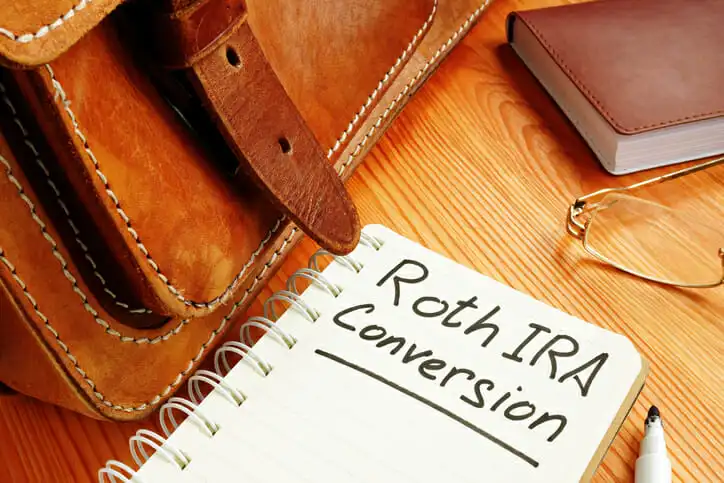A Roth Individual Retirement Account (IRA) can offer tax benefits in the form of tax-free withdrawals in retirement. If you have a traditional IRA or 401(k), you can use a Roth conversion to change the tax status of your retirement savings. Wondering how many Roth conversions per year the IRS allows? The good news is that they’re unlimited, though there are some tax rules to keep in mind when converting retirement accounts.
A financial advisor can help you create a financial plan for your retirement needs and goals.
Roth IRA Conversion Basics
A Roth IRA conversion, also known as a backdoor Roth, allows you to convert traditional retirement account contributions into Roth contributions. The types of assets you can convert include:
- Traditional IRAs
- 401(k), 403(b) and 457 plans
- SEP IRAs
- SIMPLE IRAs
Each of these accounts is funded with pre-tax dollars and qualified withdrawals are taxed at your ordinary income tax rate. Shifting those assets into a Roth IRA allows you to benefit from tax-free withdrawals when you retire.
There is, however, a caveat. When you convert traditional retirement account assets to Roth assets, you’ll have to pay ordinary income tax at the time of the conversion. The good news is that as long as you’re completing a trustee-to-trustee transfer, you don’t have to worry about paying any 10% early withdrawal penalty.
How Many Roth Conversions Per Year Does the IRS Allow?

The IRS does not put a cap on the number of Roth conversions per year you can make. You could convert all of your savings to a Roth IRA in one go or spread them out over several conversions throughout the year.
You can also complete Roth IRA conversions in multiple years, which could make sense in certain situations. Converting a large amount of money all at once could trigger a sizable tax bill if you’re pushed into a higher tax bracket. Completing multiple conversions over a period of several years could help ease the associated tax burden.
There are no dollar amount limits on how much you can convert to a Roth IRA. The IRS does, however, impose limits on contributions to Roth IRAs. The annual limit is $6,000 for 2022 and $6,500 for 2023. There’s an additional $1,000 catch-up contribution allowed for savers aged 50 and older.
How Are Roth IRA Conversions Taxed?
When you convert traditional IRA or 401(k) assets to a Roth IRA, the IRS requires you to pay ordinary income tax on the amount. Otherwise, you’d be getting all of the tax benefits without having to pay your fair share of taxes on your investment earnings.
You could use part of the assets you’re converting to pay the tax but that usually doesn’t make sense unless you’re 59 ½ or older. The IRS assesses a 10% penalty on early withdrawals from traditional retirement accounts, which includes funds used to pay taxes on conversions. So, you’d only be adding to your tax liability if you choose to go this route.
Once the conversion is complete, you’d owe no further taxes or penalties on the amount that was transferred. You would, however, need to be aware of the five-year role when converting to a Roth IRA.
Roth IRA Conversion Five-Year Rule
The five-year rule for Roth IRAs is simple. It says you have to leave any converted funds in your Roth account alone for at least five years before you can withdraw them. Otherwise, you’ll have to pay the 10% early withdrawal penalty to the IRS, unless you’re over age 59 ½.
This rule applies to converted funds, not original contributions. Those can be withdrawn tax and penalty-free at any time.
In terms of when the clock starts counting down on the five-year rule for Roth IRA conversions, it begins the first day of the calendar year in which the conversion is completed. The IRS imposes a deadline of December 31 each year for completing a Roth IRA conversion.
There’s one important thing to note if you’re planning multiple conversions, either in the same year or across different years. Each conversion is subject to its own five-year rule. For that reason, it’s important to keep track of when conversions are completed so you know when you can withdraw your Roth savings without triggering the 10% early withdrawal penalty.
Should You Convert to a Roth IRA?

Anyone can convert traditional retirement savings to a Roth IRA, regardless of income or filing status. However, whether it makes sense to do so can depend on several factors.
A Roth IRA conversion could be worth considering if you:
- Anticipate being in the same or a higher tax bracket when you retire
- Will not need to access your converted Roth assets for at least five years
- Are able to cover your conversion tax bill out of pocket
- Can claim sufficient tax deductions or credits to reduce your total tax liability at the time of the conversion
On the other hand, you might want to reconsider if you’ll have to use some of the converted assets to pay the taxes due or if you expect to be in a much higher tax bracket temporarily as a result of the conversion. You might also reconsider if you’ll be in a lower tax bracket when you retire or if you live in a state that doesn’t tax retirement income.
There are a few other things to keep in mind before moving ahead with a conversion. First, you can’t change your mind and switch your assets back later. Once the conversion is complete, it’s final.
Once you turn 73 (75 if you were born in 1960 or later), you’ll typically have to begin taking required minimum distributions (RMDs) from traditional retirement accounts. You can’t use a Roth IRA conversion as a workaround for avoiding RMDs once you turn 73, but it’s a nuanced process and you must do it the right way. Consult with your advisor or professional to make sure you’re covered.
Make sure you’re taking the right amount by starting your own RMD calculation:
Required Minimum Distribution (RMD) Calculator
Estimate your next RMD using your age, balance and expected returns.
RMD Amount for IRA(s)
RMD Amount for 401(k) #1
RMD Amount for 401(k) #2
About This Calculator
This calculator estimates RMDs by dividing the user's prior year's Dec. 31 account balance by the IRS Distribution Period based on their age. Users can enter their birth year, prior-year balances and an expected annual return to estimate the timing and amount of future RMDs.
For IRAs (excluding Roth IRAs), users may combine balances and take the total RMD from one or more accounts. For 401(k)s and similar workplace plans*, RMDs must be calculated and taken separately from each account, so balances should be entered individually.
*The IRS allows those with multiple 403(b) accounts to aggregate their balances and split their RMDs across these accounts.
Assumptions
This calculator assumes users have an RMD age of either 73 or 75. Users born between 1951 and 1959 are required to take their first RMD by April 1 of the year following their 73rd birthday. Users born in 1960 and later must take their first RMD by April 1 of the year following their 75th birthday.
This calculator uses the IRS Uniform Lifetime Table to estimate RMDs. This table generally applies to account owners age 73 or older whose spouse is either less than 10 years younger or not their sole primary beneficiary.
However, if a user's spouse is more than 10 years younger and is their sole primary beneficiary, the IRS Joint and Last Survivor Expectancy Table must be used instead. Likewise, if the user is the beneficiary of an inherited IRA or retirement account, RMDs must be calculated using the IRS Single Life Expectancy Table. In these cases, users will need to calculate their RMD manually or consult a finance professional.
For users already required to take an RMD for the current year, the calculator uses their account balance as of December 31 of the previous year to compute the RMD. For users who haven't yet reached RMD age, the calculator applies their expected annual rate of return to that same prior-year-end balance to project future balances, which are then used to estimate RMDs.
This RMD calculator uses the IRS Uniform Lifetime Table, but certain users may need to use a different IRS table depending on their beneficiary designation or marital status. It's the user's responsibility to confirm which table applies to their situation, and tables may be subject to change.
Actual results may vary based on individual circumstances, future account performance and changes in tax laws or IRS regulations. Estimates provided by this calculator do not guarantee future distribution amounts or account balances. Past performance is not indicative of future results.
SmartAsset.com does not provide legal, tax, accounting or financial advice (except for referring users to third-party advisers registered or chartered as fiduciaries ("Adviser(s)") with a regulatory body in the United States). Articles, opinions and tools are for general informational purposes only and are not intended to provide specific advice or recommendations for any individual. Users should consult their accountant, tax advisor or legal professional to address their particular situation.
Lastly, think about the timing and how the five-year rule might impact you. If you know that you’ll need at least some of your retirement assets within the next five years, you may want to hold back some of your savings and convert the rest.
Bottom Line
The IRS doesn’t limit how many Roth IRA conversions you can make but there are pros and cons associated with doing more than one conversion. On the pro side, multiple conversions can help you to spread out your tax liability, so you don’t end up with a huge tax bill. The biggest con, however, is that you’ll still owe income tax and you’ll be subject to the five-year rule.
Retirement Planning Tips
- Consider talking to your financial advisor about the best ways to manage retirement assets and taxation if you’re considering a Roth conversion. SmartAsset’s free tool matches you with up to three vetted financial advisors who serve your area, and you can interview your advisor matches at no cost to decide which one is right for you. If you’re ready to find an advisor who can help you achieve your financial goals, get started now.
- A Roth IRA conversion is not the same thing as an IRA rollover. With a rollover, you’re moving money from one like retirement account to another. For example, if you leave your job you might decide to roll your traditional 401(k) assets into a traditional IRA. Or you might roll a Roth 401(k) into a Roth IRA. The IRS does limit how often you can roll funds over. Generally, you cannot make more than one rollover from the same IRA within a one-year period.
Photo credit: ©iStock.com/Aum racha, ©iStock.com/designer491, ©iStock.com/Luke Chan
